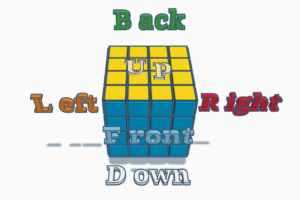What’s Special about 4×4 Notation?
THE MAIN IDEA: Rubik’s 4×4 Notation is made much simpler by learning 3×3 notation and how to solve the 3×3 first. Rubik’s 4×4 notation is like English or any language–just specific to the Rubik’s Cube. It’s how we record moves on a Rubik’s Cube, just like you would use English to write in a journal.
THE RUBIK’S 4×4 NOTATION PART: if you’re here because you know 3×3 notation already but 4×4 notation in addition confused you, 4×4 notation is just like the 3×3, except f doesn’t mean double wide turn but instead means the layer behind f. In the case of a 4×4, Fw or Ff is what denotes a double turn.
Learn the Rest
THE BASICS: there are six faces on a Rubik’s cube, and a letter for each one. F=front, B=back, U=up, D=down, R=right, L=left. If I said the letter (F) to you, that would mean turn the front face clockwise.

PRIME ROTATION: any letter with an apostrophe ‘ after it marks a prime, or counterclockwise, rotation.
DOUBLE ROTATION: F2 means rotate the front face twice. It doesn’t matter which direction.
WIDE ROTATION: Fw or Ff means rotate the front face and the middle row that goes with it.
SECOND ROW ROTATION: In contrast to the 3×3 Rubik’s cube, the symbol f in a 4×4 solve guide would notate moving the layer behind F and that layer alone. Same with any other letter.
WHOLE CUBE ROTATION: X, Y, and Z notate rotating the whole cube, along the X Y and Z axis. The X rotation is in the same direction as an R turn, Y as a U, and Z as an F.
Where to Go from Here?
If you’re still stuck, Kewbz UK has a pretty stellar guide on Rubik’s 4×4 notation.
Next, try to solve the 4×4!
